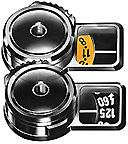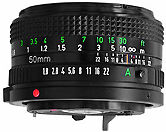Canon A-1 was the third model in the
very popular A-series SLR cameras maketed during the late '70. Canon fans have probably
expected after the introduction of the revolutionary, electronic, shutter-priority
Canon AE-1 camera in 1976 (and the Manual exposure-only
AT-1 after that), it would be easy for Canon to come out with a multi-mode automatic
exposure camera. And it was.
 |
|
This has given Canon a strong foothold
as compared with the Minolta XD-7 which has the advantage of been introduced
a year earlier than the A-1. Why ? Firstly, the A-1 has Programed AE which was not
available in the XD-7. Secondly, Canon has a very extensive accessories line-up to
take advantage of the shutter priority AE mode. There were three automatic film advance
accessories including a high speed 5 fps Motor Drive MA set while the XD-7 has only
a slow 2 fps Power Winder to offer. Other convenient system accessories and camera
operations such as interchangeable focusing screens, one hand operation for multiple
exposures has made the Canon A-1 a more logical choice for those who have the primary
preference for action-related photography. Compared with the models from the competitions
such as Fujifilm's Fujica
AX-5 in 1980,
which also offered same system configurations and camera specifications, the Canon
A-1 was the favorite among photographers because it has a larger and more complete
system accessories to back it up. During its introduction, there were already more
than 40 FD lenses of various focal lengths and applications to choose from (it has
peaked at around 60 in numbers when the T-90 was introduced in 1986). The Fujica
AX-5 only has six X-Fujinon lenses that can take advantage of the Shutter Priority
and Programmed AE modes.
 |
The Pentax K2 was one of the few early models that was introduced by Pentax during the end of 1975 with a new K-bayonet mount to replaced the popular M42-mount that has brought some very popular bodies such as the Spotmatic series. |
The new mount, however, has not been designed to provide Pentax cameras to offer shutter priority AE mode. In a way, among the top five camera manufacturers in Japan, only the Canon FD and Minolta MD lenses have such capabilities. The Nikkor lenses from Nikon were upgraded quietly in 1979 with a new AI-S series but it was not until 1983 that saw the first multimode Nikon body in Nikon FA that eventually offered both Programmed & Shutter Priority AE. In 1980, Pentax introduced another new KA-mount which allowed their new series of A-bodies (such as Super A and Super Program) to provide both Programmed and Shutter Priority AE in addition to Aperture Priority AE.
 |
When the Canon A-1 was introduced, it has an elegantly 'up market' design (compared with the Pentax K2 above and you will understand what I meant) coupled with a series of amazing features which has made it an enormous success commercially. |
How on earth was Canon able to get all of these functions into a camera weighing only 1 lb. 6 oz.? We were seeing the best of electronics technology to be offered during the mid-seventies.
There are some 20 novel technologies employed in the camera, the earlier (and huge success) of the Canon AE-1 and the subsequent A-1 has positioned and helped Canon as one of the recognized forerunner in the global electronics technological playing field.So, if someone tells me that Canon has eroded their profit on advertisements and didn't make any money at all from the AE-1 despite it has sold more than 5 million units, who would blamed them anyway ? It is hard to come by with such a golden opportunity to have a global impact, for the cost of a single product ? I think it was very cheap investment indeed.
 |
There are a couple of features in the Canon A-1 that really has wielded a long lasting influence in modern camera design. Personally, I would rate the AT-Dial in the A-1 as the most important feature - all based on the backbone of the FD lens mount. |
The input dial changed the way how a photographer input the photographic data in a camera. This was eventually refined further in the T-90 with the input dial. (Generally many camera reviewers have regarded the T90 as an upgrade of Canon A-1 and also the testbed for the autofocus EOS SLRs). Some of them have even rated the alpha-numeric LED display as the most impressive feature found on the A-1 - a solution to handle the enormous task in various automatic exposure modes.
![]() LED (Light Emitting Diode) was first seen in the Fujica ST-901 as
the primary display method for viewfinder information display. While the A-1 also
uses LED, it takes a product cycle of few years before manufacturers started to realise
other advantages of LCD (Liquid Crystal Display) and the subsequent T series models
used it as the primary display medium. But in the case of the Canon A-1, a product
of the late-seventies, it was original enough for it to utilise the LED as there
were no needles or scales commonly found in SLR cameras in the '60, '70 and even
beginning of the '80.
LED (Light Emitting Diode) was first seen in the Fujica ST-901 as
the primary display method for viewfinder information display. While the A-1 also
uses LED, it takes a product cycle of few years before manufacturers started to realise
other advantages of LCD (Liquid Crystal Display) and the subsequent T series models
used it as the primary display medium. But in the case of the Canon A-1, a product
of the late-seventies, it was original enough for it to utilise the LED as there
were no needles or scales commonly found in SLR cameras in the '60, '70 and even
beginning of the '80.
Most SLR camera during that time would require you to pull a lever or push a button
before it activates the meter. The A-1 has its meter-ON by light touching with the
shutter release button halfway - a method first used in the AE-1 in 1976 and proved
to be a trend setting feature as well. When you turn on the meter, information will
appear in 7-segment, red LED digital displays inside the viewfinder, below and out
of the way of the field of view. This is controlled by a combination of the AE Mode
Selector and so-called AT Dial, the former located around the shutter release button,
the latter just underneath it.
 |
There are a lot more that can be said about this camera. Some of the features were generous enough even they were to be measured by today's standard, like its unusually wide metering range, which works with the widest film speed ever found in any 35mm SLR camera, from ISO 6 to 12,880. |
Or how about exposure compensation over a full +2 f/stop range is possible at 1/3 f/stop increments. And the A-1 has a group of dedicated system accessories on its own (like Motor Drive MA, interchangeable focusing screens, etc) but most of the general acccesories were also designed to be compatible with other models within the A series like the Power Winder A/A2, dedicated Canon Speedlites, Canon FD(n) and even older FL lenses and other accessories for close-up, photomacrography and photomicrography. In fact, the A-1 was the only SLR during its time that need not to have control the aperture value by the lens aperture ring - because the lens' aperture ring always stays on automatic "A" (except for stopped-down AE and manual operation) the A-1 can be controlled using only your right thumb and index finger.
 |
This concept has excellent human engineering and leads to eventual development of Canon's latest version for the EOS AF SLR cameras' popular "Command Dial". |
| Previous | Next | 2/8
| Back | Index Page of Canon A-1
| Back | Main Index Page of Canon SLR Models
History & Background | Basic Camera Operation (14 Parts)
Main Reference Map - HTML | PDF (270k)
Specification - HTML | PDF (96k)
Shared Resources: Winder A, Winder A2, Focusing Screens, Motor Drive MA, Databack A, Speedlites & Macro photography.
Canon FD Resources
A Series: AE-1 | AT-1 | A-1 | AV-1 | AE-1 Program | AL-1
T- Series: T50 | T60 | T70 | T80 | T90
F-1 | New F-1
Canon FL Resources Pellix | FTQL
FL | Canon FDn lenses. | Early versions of FD lenses
Canon EOS SLRs | Canon EF lens Resources
Highly suggestive useful external links/resources created by Mr.Christian Rollinger:
Essentials: - Canon A1 Repair/Service Guide | Determine Years of Made of your
Canon
Canon Flash models:- Canon 300TL flash(1.5MB); Macrolite ML-1(HTML); Macrolite ML-2;
Macrolite ML-3; Speedlite 133a; Speedlite 155a(HTML); Speedlite 177a; Speedlite 188a(HTML); Speedlite 199a; Speedlite 244t; Speedlite 277t (HTML); Speedlite
533; Speedlite 577
Others:- Canon Auto Bellow Unit Manual; Canon Macro Photography Guide, Canon Slide Duplicator Manual, Canon Angle Finder User's Manual
| Message Board |
for your Canon
A-Series SLR camera(s)
| Message Board | for your Canon optics
in a shared environment
| Message Board | Specifically for Dispose or Looking for Canon Photographic
Equipment
Home - Photography in Malaysia
![]()
Copyright
© 2000.
leofoo ®. MIR Web Development Team.
Maintenance
Team: Kaipin, Terry Carraway & Dr Strangelove; Pawel Nabe for his image
on the Data Memory Back. EEwyn Foo, my nephew, who
has spent quite a number of nights converting the original manual in HTML format.
Mr. Richard Yeow, General Manager
-Optical Division of Canon Marketing for granting special
permission to reproduce this manual into HTML format in his site as a form of obligation
to all Canon FD mount users worldwide.
* Canon, FD Lenses, Canon Marketing are registered
trade names or trademarks of Canon
Inc. Japan.